Pike livebearer - Belonesox belizanus
Scientific name: Belonesox belizanus
Common name: Pike livebearer
Family: Poeciliidae
Usual size in fish tanks: 12 - 15 cm (4.72 - 5.91 inch)
014
Recommended pH range: 6.8 - 8.2
Recommended water hardness: 12 - 30°N (214.29 - 535.71ppm)
0°C 32°F30°C 86°F
Recommended temperature range: 25 - 30 °C (77 - 86°F)
The way how these fish reproduce: Pseudo-Livebearer
Where the species comes from: Central America
Temperament to its own species: peaceful
Temperament toward other fish species: aggressive to smaller
Usual place in the tank: Middle levels
Origin and Natural Habitat
The Pike Livebearer (Belonesox belizanus) originates from the freshwater and coastal regions of Central America, including Nicaragua, Guatemala, Honduras, and El Salvador. This predatory species thrives in slow-moving, oxygen-poor waters with dense aquatic vegetation, which provides excellent cover for ambushing prey.
In the wild, Pike Livebearers are highly adaptable and can be found in both freshwater and brackish water environments, depending on the specific habitat. They often seek shelter among floating and submerged plants, such as aquatic vegetation, which helps them stay concealed from predators while stalking their own prey.
Due to their adaptability and aggressive hunting nature, Pike Livebearers have been introduced into non-native regions, where they may pose a threat to local fish populations.
Lifespan and Longevity
The Pike Livebearer (Belonesox belizanus) has an average lifespan of 5 years or more in captivity when provided with optimal care. Their longevity depends on several factors, including stable water conditions, a well-maintained tank, and a nutritionally balanced diet.
To maximize their lifespan, it’s crucial to ensure proper filtration, water quality, and a suitable environment that mimics their natural habitat. Regular monitoring of water chemistry, along with a high-protein diet rich in live and frozen foods, can significantly improve their health and longevity.
Diet and Feeding Habits
The Pike Livebearer (Belonesox belizanus) is a highly carnivorous predator that thrives on a protein-rich diet. In the wild, these fish actively hunt small fish, insects, worms, and crustaceans. Their natural hunting instinct makes them best suited for a diet of live foods, but they can also adapt to high-quality frozen or freeze-dried meaty foods.
In captivity, their diet should include:
- Live feeder fish: Guppies, mollies, or other small fish
- Insects and larvae: Mosquito larvae, crickets, mealworms
- Frozen or freeze-dried options: Bloodworms, shrimp, krill
Since Pike Livebearers have a voracious appetite, it’s essential to manage their feeding to prevent overconsumption. Feeding them multiple small meals per day rather than large feedings can help maintain their health. While feeder fish can be part of their diet, supplementing with nutritionally balanced protein sources ensures proper growth and reduces the risk of deficiencies.
Providing a varied diet that mimics their natural hunting behavior is key to keeping them healthy in an aquarium setting.
Sexing Pike Livebearers
Distinguishing between male and female Pike Livebearers (Belonesox belizanus) is relatively straightforward due to their significant size difference. Females grow nearly twice as large as males, reaching up to 20 cm (8 inches) in length, whereas males remain noticeably smaller.
Additional differences include:
- Females: Slight red tint on the anal fin and a less distinct caudal peduncle spot
- Males: More prominent gonopodium (modified anal fin for reproduction) and a darker caudal peduncle spot
Breeding Pike Livebearers
Pike Livebearers are prolific breeders and can produce up to 120 fry per batch. To create an optimal breeding environment, consider adding a small amount of salt to the breeding tank to replicate their natural brackish water conditions.
Key breeding considerations:
- Fry production: The number of fry depends on the female’s age and health, with older females typically producing larger broods.
- Fry protection: Newly born fry must be transferred to a separate grow-out tank to prevent predation by adult Pike Livebearers.
- Cannibalism risk: The fry themselves can exhibit cannibalistic behavior, so separating larger fry from smaller ones is essential as they grow.
Feeding Fry: Newly hatched fry require small, protein-rich foods, such as micro-worms and baby brine shrimp. As they mature, they can gradually transition to larger live foods similar to what adult fish consume.
Although breeding Pike Livebearers is relatively easy, raising the fry can be demanding due to their constant need for food and space. These aggressive predators require frequent feedings, and managing their rapid growth can be challenging. Aquarists should be prepared for the substantial effort involved and consider the limited demand for this species in the aquarium trade before undertaking large-scale breeding projects.
Short Description
The Pike Livebearer (Belonesox belizanus) is a predatory fish that thrives in low-oxygen waters dense with aquatic vegetation. This species is highly skilled at ambushing prey, making it a formidable predator in both freshwater and brackish environments. As they mature, their aggressive tendencies intensify, requiring a carefully planned tank setup to prevent conflicts with smaller or passive fish.
Tank Setup & Compatibility
Due to their aggressive nature, it is recommended to keep Pike Livebearers in a species-only aquarium or with large, robust tank mates that can defend themselves. A spacious, well-planted aquarium is essential, as these fish rely on dense vegetation for cover and comfort. Floating plants are particularly useful for diffusing light and creating shaded areas that reduce stress.
- Lighting: Pike Livebearers prefer dimly lit aquariums. Excessively bright lighting can cause stress, making them feel vulnerable.
- Water Conditions: This species can tolerate both freshwater and brackish setups. Adult Pike Livebearers often fare better in slightly brackish water, with a recommended salt concentration of one tablespoon per 3.8 liters (1 US gallon).
Livebearer Connection
Despite their predatory nature and large size, Pike Livebearers belong to the same family as popular aquarium species like Guppies and Swordtails. Like their smaller relatives, they are livebearers, meaning they give birth to fully developed fry instead of laying eggs. A single female can produce multiple batches of fry per year, making them highly prolific breeders.
Pictures
Bought by aqua-fish.net from jjphoto.dk.
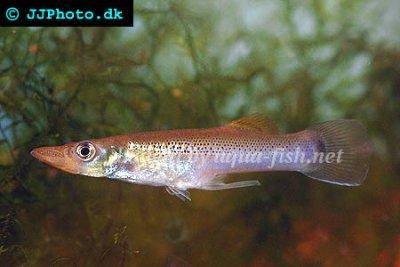



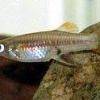 Biskop-tandkarpe
Biskop-tandkarpe 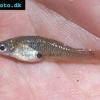 Mosquito
Mosquito 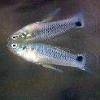 Twospot
Twospot  South
South 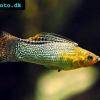 Sailfin
Sailfin 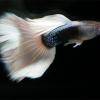 Guppy
Guppy  Short
Short  Endler’s
Endler’s 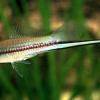 Swordtail
Swordtail 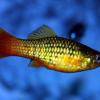 Platy
Platy 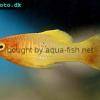 Variegated
Variegated